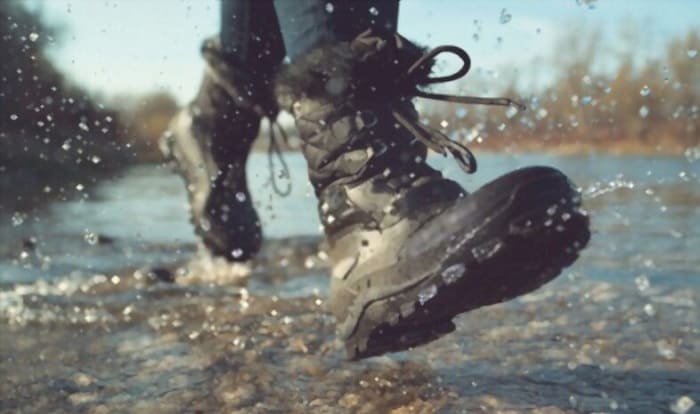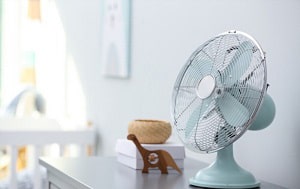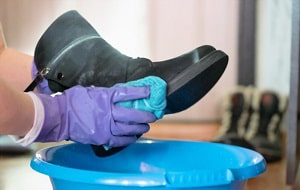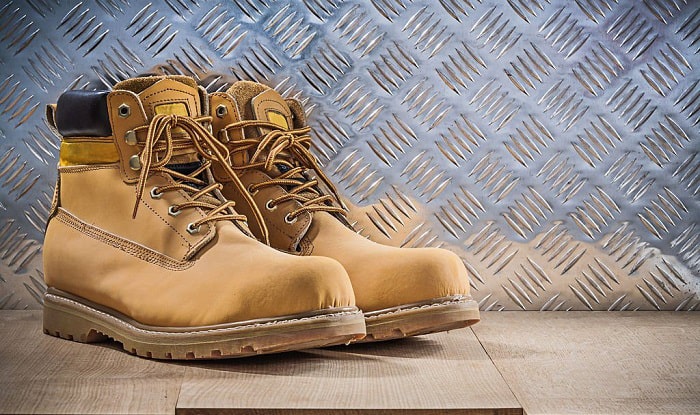Manufacturers usually use thick and sturdy materials for work boots, which helps to maximize their level of protection but might take forever to dry. After years of wearing safety shoes, I have to admit that drying them is one of the most tedious maintenance chores.
So, in this article, I have compiled the five best methods to speed up this process for my fellow boot wearers. Wet shoes create the perfect condition for bacteria and odor to grow. So, keep reading for how to dry work boots fast.
Table of Contents
Five Methods to Dry Work Boots Fast
Before you proceed to dry wet leather boots, clean the mud and grime on them. Dirty spots can leave stains on leather once they are dry. Follow this procedure to clean your boots:
- Remove the shoe laces and insoles. Then, wash them in soapy water and dry them separately.
- Dampen a cloth, apply saddle soap on it, and use it to clean the shoes’ exterior. You can use a toothbrush to scrape off the dirt around the soles, creases, and uppers. If you work with mesh fabric, replace saddle soap with mild soap.
- Blot up the soap residue with a clean cloth.
- Gently squeeze the boots and pat them with a towel to remove as much moisture as possible.
Now, you can choose to dry boots fast with old newspapers, rice, a fan, a towel, or a boot dryer. Read below to find the method that suits you.
Method #1: Newspapers
Stuffing wet work boots with newspapers is the best way to dry them without harming the delicate materials. You won’t have to worry about stressing the shoes, applying excessive heat, or overdrying them.
For this method, all you need to prepare is some old newspapers.
Follow these steps to dry rain boots quickly:
You can change the newspapers every two to three hours to quicken the drying process.
Method #2: Rice
If you have accidentally spilled water on your phone, you know that rice can be a lifesaver for absorbing moisture. The same concept can be applied to dry wetting boots. You should prepare:
- A container large enough to hold your boots
- Uncooked rice
- Socks
You can replace rice with other grains, such as quinoa or couscous.
Follow these steps to dry steel toe boots fast: The rice will completely absorb the moisture in your boots after two to three hours.
Method #3: Fan
If you have a fan at home, why not use its air currents to quick dry boots? This method is best to dry inside of boots and remove the musty smell. You will need:
- A sturdy table fan or a floor fan
- A towel
- Old wire
Here are three steps you should follow:
Never use a heated fan for this method. Excessive heat will crack leather, shrink rubber, and peel off the glue in the shoe soles.
Method #4: Towel
Similar to the newspaper method, you can use towels to soak up the water in your wet shoes.
If you have left your safety shoes in a ventilated place for more than 24 hours and they still feel damp, quickly grab two old towels (one for each boot) and proceed as follows: The towels will absorb the moisture in just a few hours while maintaining the perfect shape of your boots.
Method #5: Boot dryer
Many winter glove and boot dryers are available on the market, with prices ranging from $30 to $100.
If you live in a cold climate and always have trouble drying your boots, we suggest investing in a high-quality boot dryer. It is the fastest way to remove moisture from bulky work boots.
This device will constantly blow heat at around 105°F (40.5°C) to your boots, which is the right temperature to dry waterproof boots fast without harming their liners or water-resistant garments.
All you need to do is to put the shoes on the holder, turn on the switch, and let the device do its job.
To better remove the wet boot odor, you can follow these steps:
FAQs
Is it safe to put boots in the dryer?
Most shoes shouldn’t be put in the tumble dryer. Intense heat will dry out the garments, warp your shoes, and affect the glue that holds layers of the outsoles together. Dry out leather boots will eventually crack and lose their water resistance.
If you can’t find any alternative method, you can put your shoes in dryer. But stick to these steps:
- Pull out the drying rack that is on top of the dryer (the rack for flat drying clothes).
- Place your boots on the rack to distance them from the heat source.
- Set your tumble dryer at the lowest temperature and turn it on.
How long does it take to dry boots on a boot dryer?
It only takes one to two hours to dry boots with a boot dryer. If your shoes are soaking wet, don’t forget to squeeze and pat them with paper or towels to remove as much moisture as possible before drying them.
Can you dry boots in the oven?
We don’t recommend drying boots in oven or microwave. As mentioned above, intense heat will damage the design of your shoes.
If your shoes have Polyurethane (PU) soles, they can ignite when exposed to high heat, releasing carbon monoxide and nitrogen oxides and irritating your respiratory system.
Can I use a hair dryer to dry boots?
Yes, you can. Follow this procedure to dry boots with hair dryer:
- Remove the shoe laces and inner soles and dry them separately.
- If your shoes are dirty, don’t forget to wash them thoroughly before drying them.
- Use a towel to absorb the excess moisture, then position the shoes vertically against a sturdy platform.
- Place your hair dryer 10 to 15 inches away from the boots, put it on the cold setting, and turn it on.
It will take at least several hours, so you should check the progress regularly to make sure the shoes are not damaged. The downside of this method is that the hair dryer might be noisy and consume a lot of electricity.
Conclusion
There, you have the most effective methods on how to dry work boots fast! Now, you can say goodbye to soggy and smelly boots during everlasting winters.
When leather boots get wet, water will bind to the material molecules and draw out the leather’s natural oil when it evaporates. When this process repeats constantly, your boots will crack and lose their protective functions. So, don’t forget to apply leather conditioner after drying them.
If you find this article helpful, feel free to share it with your colleagues and friends. Everyone can use some good advice on lengthening the lifespan of their safety footwear. Thank you for reading!

Veronica is our content editor. She is a talent in delivery. Her main work is editing and writing articles that are both informative and simple to follow. She is in charge of synthesizing our understanding of what personal protection equipment (PPE) is needed in each job, how to best apply it, and how to visualize that equipment.








